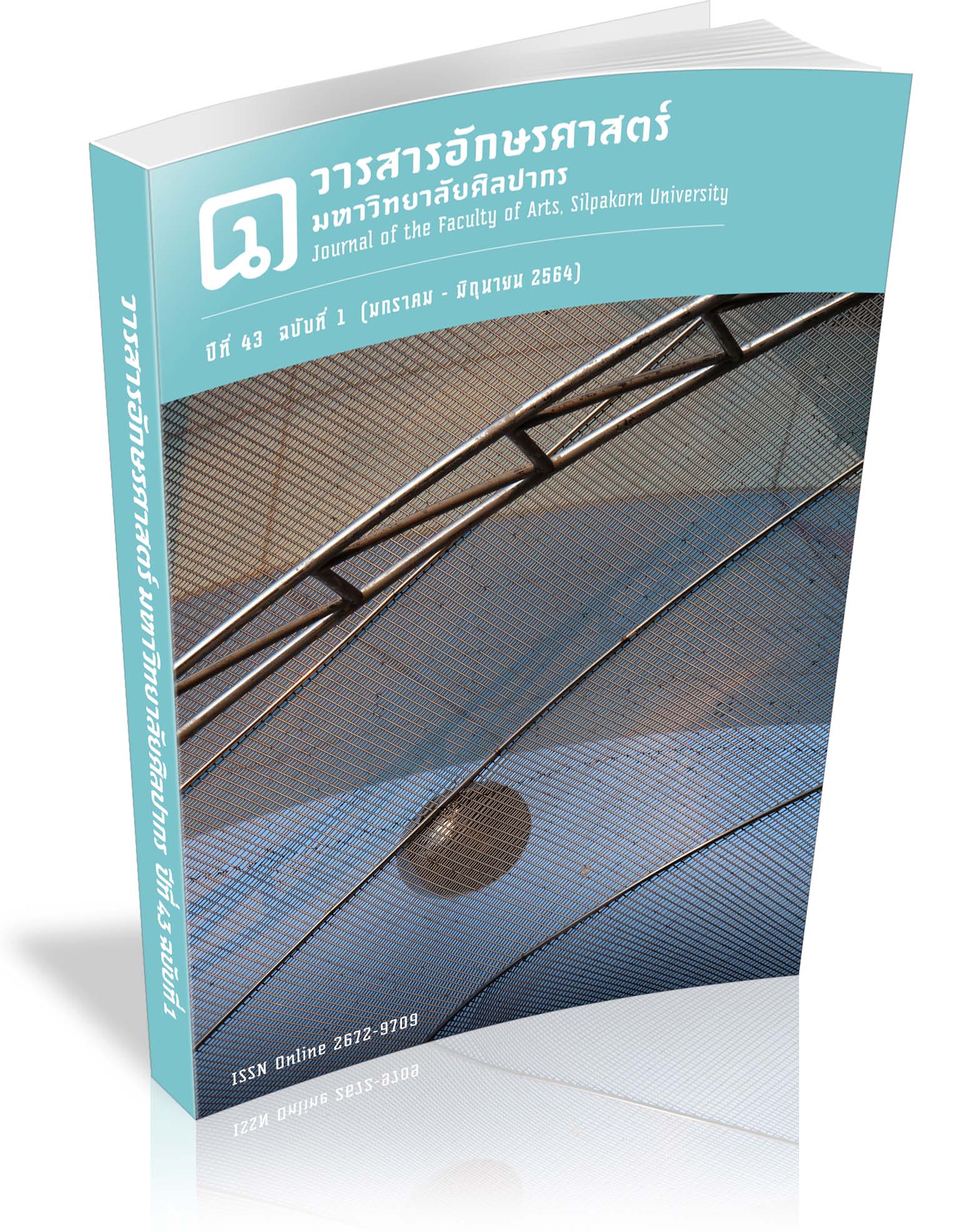Japanese-Thai Translation Strategies for Connecting Clauses
Keywords:
Japanese-Thai translation, clauses, linkersAbstract
This paper investigates Japanese-Thai translation strategies for connecting clauses, using data from Japanese novels and their Thai translations. Considering sentence structure in source and target texts, translation strategies may be summarized as follows. 1) Using identical sentence structure as the source text, that is, “connecting clause + main clause” (or the reverse) may be divided into two subtypes: a) the case in which no clause linkers are used as the connecting clause meaning is clear enough for comprehension; this subtype is often found in coordinate, temporal sequence, and causal clauses; and b) using clause linkers, for which there is a tendency to use according to semantic types of clauses (for example, temporal sequence clauses tend to use linkers showing temporal sequence). Notably, different linkers are widely used, and careful consideration should be given when using some linkers (such as the linker of cause “เพราะ” (prɔ́), which does not usually occur at the beginning of sentences). 2) Using one simple sentence in which serial verb constructions, serial verbs with linkers, word adjustments, and sentence structure adjustments are found.
Downloads
References
Chawengkijwanich, S. (2017). Problems of Translating Japanese into Thai and the Causes. Japanese Studies Journal, 34(2), 75-91. (In Thai)
Chawengkijwanich, S. (2018). Translation theory and techniques. Pathumthani: Thammasat University Press. (In Thai)
Chawengkijwanich, S. (2020a). Problems in Japanese to Thai translation: problems in sentence construction. Journal of Liberal Arts, 20(1), 41-67. (In Thai)
Chawengkijwanich, S. (2020b). Flow of Information in Translation from Japanese into Thai. Thammast University. (In Thai)
Diessel, H. (2001). The ordering distribution of main and adverbial clauses a typological study. Language, 77, 345-365.
Diessel, H. (2004). The Acquisition of complex sentences. Cambridge: Cambridge University Press.
Diessel, H. (2005). Competing motivations for the ordering of main and adverbial clauses. Linguistics, 43, 449-470.
Fuangraya, N. & Thippasurat, N. (2015). Kaanwikhroh kaanprabbotplae lae konlawithi kaanplae ruang “Khon tua jiw”. Rangsit University Journal of Factulty of Liberal Arts, 11(19), 61-71. (In Thai)
Iori, I. (2001). Atarashii nihongogaku nyuumon. Tokyo: 3A network. (In Japanese)
Intasaw, N. (2013). Thai Clause Segmentation Using a Support Vector Machine Model. [Unpublished master’s thesis]. Chulalongkorn University. (In Thai)
Iwasaki, S., & Ingkaphirom, P. H. (2005). A Reference Grammar of Thai. Cambridge: Cambridge University Press.
Kataoka, S., & Kim, Y. G. (1989). hon’yaku eibumpou houshiki ni yoru ei-nichi hon’yaku toreiningu manyuaru 2. Tokyo: Babel Press. (In Japanese)
Katori, Y. (2009). Nihongo tekusuto no kessokusei kara kangaeru –ei-nichi hon’yaku ni okeru nozomashii shiten no torikata shisen no mukekata. Invitation to Interpreting and Translation Studies, 3, 51-64. (In Japanese)
Kawahara, K. (2007). Ninchi-imiron ni yoru yakugo sentaku to sono shidouhou –‘as’ no jireikenkyuu-. Invitation to Interpreting and Translation Studies, 1, 79-95. (In Japanese)
Khruachot, S. (2019). An Analytical Study of Translation Editing and Translation Process of the Children’s Literature “The Lion the Witch and the Wardrobe”. Journal of Education Review, 6(2), 93-102. (In Thai)
Levinsohn, S. H. (1992). Preposed and postposed adverbials in English. Work Papers of the Summer Institute of Linguistics, University of North Dakota Session, 36, 19-31.
Maeda, N. 2004. Gendai nihongo ni okeru ‘youtaisetsu’ o megutte -sono taikeisei to renzokusei’ Kenkyuu Nenpou 50, 115-134. (In Japanese)
Maruyama T., Sato S., & Natsume K. 2016. Gendai nihongo ni okeru setsu no bunrui taikei ni tsuite. Proceedings of the 22nd Annual Meeting of the Association for Natural Language Processing: 1113-1116. (In Japanese)
Masuoka, T., & Takubo, Y. (1992). Kiso Nihongo bumpou –kaiteiban. Tokyo: Kuroshio. (In Japanese)
Nakamura, Y. (2001). Souzou suru hon’yaku. Tokyo: Kenkyusha. (In Japanese)
Noda, H. 2002. Tanbun fukubun to tekisuto. Nihongo no bunpou 4. Tokyo: Iwanami shoten. (In Japanese)
Piyapasuntra, S. (2013). Compound and Complex Sentences in Thai Academic, Political, Legal and Media Registers. Wanwithat, 13, 115-139. (In Thai)
Ruchirawan, M. (1984). Linguistics: Towards a descriptive model of Thai-English translation. [Unpublished doctoral dissertation]. Georgetown University.
Saibua, S. (1995). Principle of translation. Bangkok: Thamasat University Press. (In Thai)
Tanabe, K., & Mitsufuji, K. (2008). Building Translation Skills. Tokyo: Sanshuusha. (In Japanese)
Taoka, I. (2006). The positions of Although clauses and their interpretation. Memoirs of the Osaka Institute of Technology, Series B, 51: 1-8. (In Japanese)
Thepkanjana, K. (1986). Serial Verb Constructions in Thai, [Unpublished doctoral dissertation]. University of Michigan.
Thompson, S. A., Longacre, R. E., & Hwang, S. J. (2007). Adverbial clauses. in T. Shopen(ed.), Language typology and syntactic description, Volume 2: Complex constructions (2nd ed.), (pp. 237-269). Cambridge: Cambridge University Press.
Yamada, M. (2018). Tsuuyaku hon’yaku kenkyuu no sekai –hon’yaku kenkyuu hen–jun’okuri-yaku to jouhou kouzou. Tsuushin hon’yaku Journal 2018 SUMMER. Tokyo: Ikaros. (In Japanese)
Yamamoto, K. 2010. Recent Developments and Perspectives on Translation Studies in Thai Context. International Conference on Language and Communication Proceedings: 25-33.
Yuan, Q. (2017). Nihon no dorama ni okeru iisashibun to chuugokugo jimaku no hon’yaku senryaku –poraitonesu no kanten kara. Invitation to Interpreting and Translation Studies, 17, 50-63. (In Japanese)
Downloads
Published
How to Cite
Issue
Section
License
ผู้เขียนบทความต้องยินยอมในข้อกำหนดต่าง ๆ ของวารสารก่อนส่งบทความตีพิมพ์




